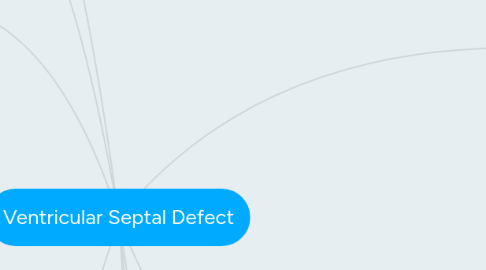
1. lab
1.1. cbc
1.1.1. infection/anemia
1.2. cmp
1.2.1. dehydration/elec. imbalance
1.3. pulse ox while feeding
1.4. TSH
2. PE
2.1. Pulmonary exam
2.1.1. rales heard bilaterally
2.2. Abdominal exam
2.2.1. normal
2.3. CV exam
2.3.1. S3 holosystolic murmur Grade III-IV blowing @ tricuspid
2.3.1.1. smaller defect = louder murmur heard
2.3.1.2. large defect = may be asymptomatic
2.4. vitals
2.4.1. same birth weight at 2 mo.
2.5. well-baby exam
3. Imaging
3.1. CXR
3.1.1. cardiomegaly CT ratio 6.5
3.2. Echo
4. Treatment
4.1. Pediatric Cardiology referal
4.1.1. surgical repair via cardiac cath, umbrella plug
4.1.2. nonsurgical repair
4.1.2.1. digitalis (digoxin)
4.1.2.2. vasodilator to dec. BP
4.1.2.3. diuretic for CHF
4.1.2.4. prophylactic antibiotic
4.1.2.5. high calorie diet and normal activity
5. Patient Education
5.1. Parent education
5.1.1. Emergent symptoms/CHF
5.1.2. When surgery may be needed ie. medication no longer controls or baby not growing
5.1.3. Surgical repair-may need replacement/repair later in life
5.1.4. No medication/restrictions after surgery
5.1.5. regular checkups
5.1.6. Signs or possibility of Eisenmenger Syndrome
6. Acyanotic (L to R shunt),
6.1. Endocardial cushion and interventricular septum don't align in embryology
6.1.1. may close on it's own
6.1.1.1. 75-80% close by 10 yrs old
6.1.2. perimembranous= most common
6.1.3. muscular and outlet also exist
6.2. usually identified within 2 months of birth
7. Signs/Symptoms
7.1. depend on size and location of defect.
7.2. mixing of oxygenated and deoxygenated blood-cyanotic
7.3. failure to thrive
7.3.1. under 5%
7.4. with exertion/feeding
7.4.1. diaphoresis
7.4.2. dyspnea
7.5. neonatal LV not enlarged=can't accommodate w inc. volume
7.5.1. CHF
7.5.1.1. pulmonary edema
7.5.1.2. edema
7.5.1.3. dec. urine output
7.5.1.4. ascites
7.5.1.5. irritability
7.5.1.6. tachycardia
8. epidemiology
8.1. most common congenital defect
8.2. 5-50/1000 newborns
8.3. slightly more common in women
9. risk factors
9.1. genetic
9.2. mothers lifestyle habits
9.2.1. medications
9.2.2. drugs/alcohol
10. Pathophysiology
10.1. 3 hemodynamic consequences of L to R shunt
10.1.1. Inc. L ventricle volume load
10.1.2. Excessive pulmonary bloodflow
10.1.3. Red. systemic cardiac output
10.1.3.1. CO=SV x HR
10.1.3.2. BP=PVR x CO
11. Congenital Heart Defects
11.1. Cyanotic
11.1.1. R to L shunt
11.1.1.1. Tetralogy of Fallot
11.1.1.1.1. 1.Pulmonary stenosis. 2.RVH 3.Overriding Aorta 4. VSD
11.1.1.2. Pulmonary Atresia
11.1.1.3. Hypoplastic L heart
11.1.1.4. Transposition of Great Vessels
11.2. Acyanotic
11.2.1. L to R shunt
11.2.1.1. *VSD
11.2.1.1.1. holosystolic, Lower LSB (depends on severity)
11.2.1.1.2. most common defect
11.2.1.2. *ASD
11.2.1.2.1. 80% septum secundum (embryology)
11.2.1.2.2. PFO
11.2.1.2.3. systolic ejection murmur at 2nd LICS, early/middle systole rumble, RV heave
11.2.1.3. Obstructive
11.2.1.3.1. *Aortic Stenosis
11.2.1.3.2. Coarctation of Aorta
11.2.1.4. Patent Ductus Arteriosus
11.2.1.4.1. Inc. Pul. blood flow, inc. Pul Venous return, Inc. Pul pressure.
11.2.1.5. Atrial Ventricular Canal
11.2.1.5.1. incomplete fusion of endocardial cushions
11.3. Eisenmenger's
11.3.1. VSD/ASD change to R to L shunt
11.3.1.1. more severe
